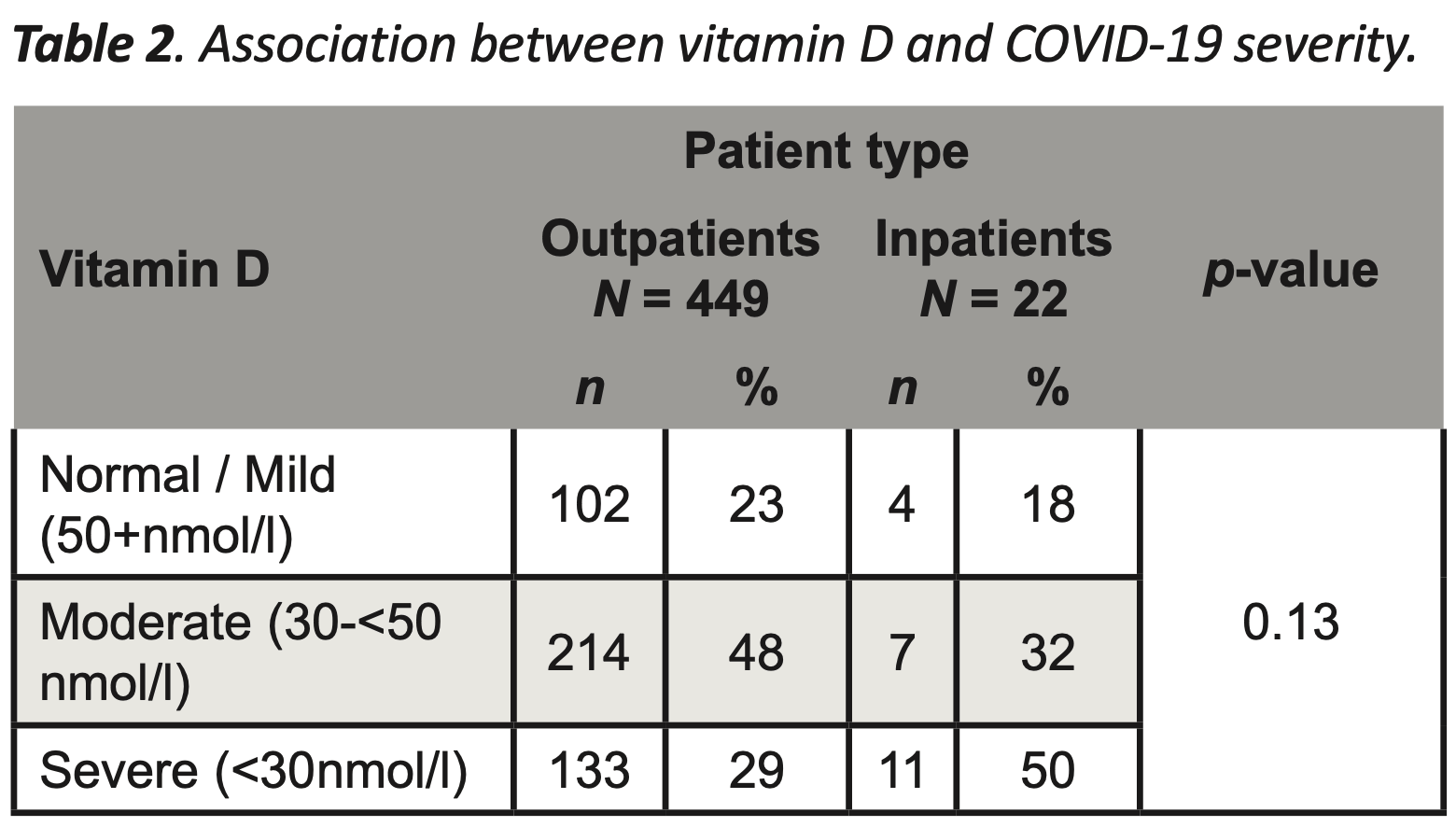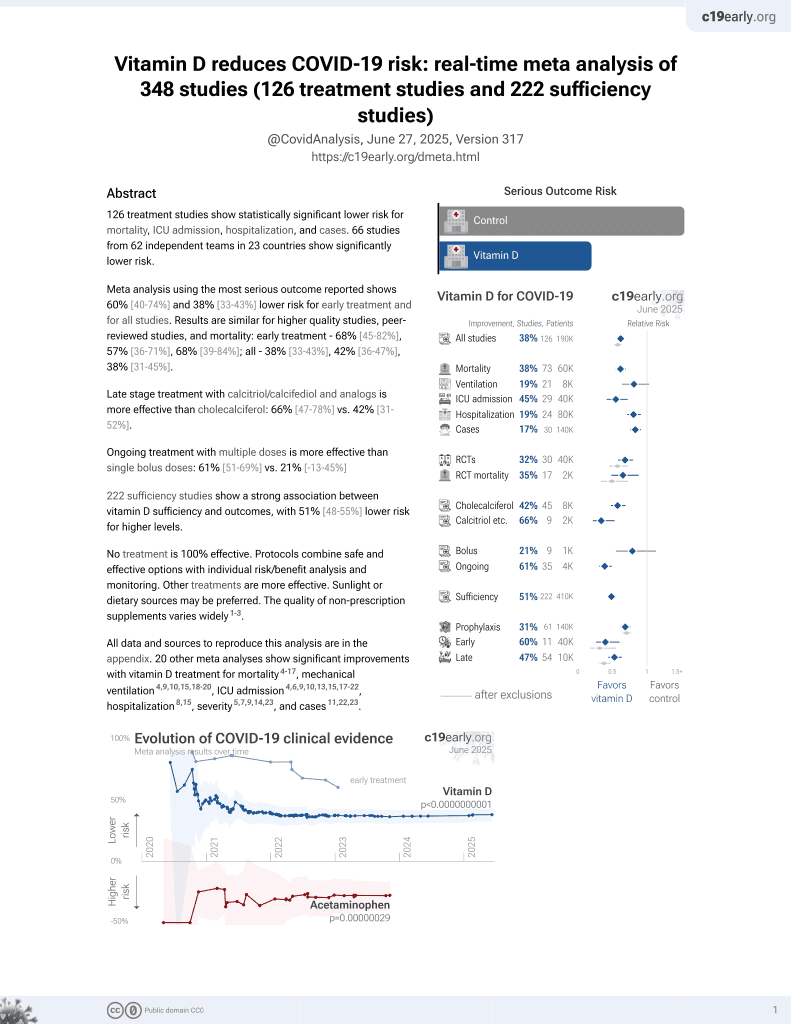
Investigating the relationship between vitamin D levels and COVID-19 severity among patients at MNGHA in Saudi Arabia
et al., International Journal of Medicine in Developing Countries, doi:10.24911/IJMDC.51-1747240075, Oct 2025
Vitamin D for COVID-19
8th treatment shown to reduce risk in
October 2020, now with p < 0.00000000001 from 126 studies, recognized in 18 countries.
No treatment is 100% effective. Protocols
combine treatments.
6,300+ studies for
210+ treatments. c19early.org
|
Cross-sectional study of 471 COVID-19 patients in Saudi Arabia showing no significant association between vitamin D levels and COVID-19 severity in unadjusted results.
This is the 226th COVID-19 sufficiency study for vitamin D, which collectively show higher levels reduce risk with p<0.0000000001 (1 in 115,066,047,903,039,356,928 vigintillion).
|
risk of hospitalization, 51.2% lower, RR 0.49, p = 0.29, high D levels (≥50 nmol/l) 4 of 129 (3.1%), low D levels (<30 nmol/l) 11 of 173 (6.4%), NNT 31.
|
| Effect extraction follows pre-specified rules prioritizing more serious outcomes. Submit updates |
Nahhas et al., 1 Oct 2025, retrospective, Saudi Arabia, peer-reviewed, mean age 42.0, 5 authors.
Contact: anazia@ksau-hs.edu.sa.
Investigating the relationship between vitamin D levels and COVID-19 severity among patients at MNGHA in Saudi Arabia
International Journal of Medicine in Developing Countries, doi:10.24911/ijmdc.51-1747240075
Objective: This study aimed to assess the clinical and laboratory characteristics of patients infected with COVID-19, and to investigate the relationship between COVID-19 severity and their vitamin D levels.
Methods: This cross-sectional study was conducted at the Ministry of National Guard Health Affairs, among a total of 471 COVID-19 patients who were infected during the years 2020 and 2021. Patients were identified through the infection control department, the intensive care unit, and medical records.
Results: The mean age of the study participants was 42 ± 10.28 years, with the majority of female cases (60%) occurring in the year 2020. Nearly half of the overall patients (49%) were admitted through the emergency department. There was no statistically significant association between low vitamin D levels and the severity of COVID-19 symptoms (p-value = 0.13). The most common symptoms across all patients were upper respiratory tract infections, including nasopharyngitis, tonsillitis, and otitis media, but were nearly twice as common in outpatients. Notably, muscle injury was the only symptom with a statistically significant association with vitamin D deficiency (p-value=0.031). Both males (n = 94) and females (n = 127) had moderate vitamin D deficiency, with females being significantly more vitamin D deficient than males (p-value = 0.018).
Conclusion: It was found that there was no significant correlation between reduced serum vitamin D levels and the severity of COVID-19 symptoms. Further multicenter studies on a larger scale are needed to clarify the role of vitamin D deficiency in the progression of COVID-19.
List of Abbreviations
Conflict of Interest The authors declare that there is no conflict of interest regarding the publication of this article.
Consent for Participation Informed consent was obtained from all the participants.
References
Al-Alyani, Ha, On, Alani, Sadat-Ali, Vitamin D deficiency in Saudi Arabians: a reality or simply hype: a meta-analysis (2008-2015), J Fam Commun Med, doi:10.4103/jfcm.JFCM_73_17
Alguwaihes, Sabico, Hasanato, Me, Megdad et al., Severe vitamin D deficiency is not related to SARS-CoV-2 infection but may increase mortality risk in hospitalized adults: a retrospective casecontrol study in an Arab Gulf country, Aging Clin Exp Res, doi:10.1007/s40520-021-01831-0
Alkhafaji, Argan, Albaker, Elq, Al-Hariri et al., The impact of vitamin D levels on the severity and outcome of hospitalized patients with COVID-19 disease, Int J Gener Med, doi:10.2147/IJGM.S346169
Alzaheb, The prevalence of hypovitaminosis D and its associated risk factors among women of reproductive age in Saudi Arabia: a systematic review and meta-analysis, Clin Med Insights, doi:10.1177/1179562X18767884
Cao, COVID-19: immunopathology and its implications for therapy, Nat Rev Immunol, doi:10.1038/s41577-020-0308-3
Chang, Lee, Vitamin D and health: The missing vitamin in humans, Pediatr Neonatol, doi:10.1016/j.pedneo.2019.04.007
Feldman, Glorieux, Pike, Vitamin, None
Ghasemian, Shamshirian, Heydari, Malekan, Alizadeh-Navaei et al., The role of vitamin D in the age of COVID-19: a systematic review and meta-analysis, Int J Clin Pract, doi:10.1111/ijcp.14675
Grant, Lahore, Mcdonnell, Baggerly, French et al., Evidence that vitamin D supplementation could reduce the risk of influenza and COVID-19 infections and deaths, Nutrients, doi:10.3390/nu12040988
Hastie, Pell, Sattar, Vitamin D and COVID-19 infection and mortality in UK Biobank, Eur J Nutr, doi:10.1007/s00394-020-02372-4
Huang, Wang, Li, Ren, Zhao et al., Clinical features of patients infected with the 2019 novel coronavirus in Wuhan, China, Lancet, doi:10.1016/S0140-6736(20)30183-5
Medrano, Carrillo-Cruz, Montero, Perez-Simon, Vitamin D: effect on haematopoiesis and immune system and clinical applications, Int J Mol Sci, doi:10.3390/ijms19092663
Meltzer, Best, Zhang, Vokes, Arora et al., Association of vitamin D status and other clinical characteristics with COVID-19 test results, JAMA Netw Open, doi:10.1001/jamanetworkopen.2020.19722
Mutair, Alhumaid, Alhuqbani, Zaidi, Alkoraisi et al., Clinical, epidemiological, and laboratory characteristics of mild-to-moderate COVID-19 patients in Saudi Arabia: an observational cohort study, Eur J Med Res, doi:10.1186/s40001-020-00462-x
Radujkovic, Hippchen, Tiwari-Heckler, Dreher, Boxberger, Vitamin D deficiency and outcome of COVID-19 patients, Nutrients, doi:10.3390/nu12092757
Sarría-Santamera, Mukhtarova, Baizhaxynova, Kanatova, Zhumambayeva et al., Association of CYP24A1 gene rs6127099 (A> T) polymorphism with lower risk of COVID-19 infection in Kazakhstan, Genes, doi:10.3390/genes14020307
Sassi, Tamone, Amelio, Vitamin D: nutrient, hormone, and immunomodulator, Nutrients, doi:10.3390/nu10111656
Singh, Kaur, Singh, Revisiting the role of vitamin D levels in the prevention of COVID-19 infection and mortality in European countries post-infection peak, Aging Clin Exp Res, doi:10.1007/s40520-020-01619-8
Xu, Shi, Wang, Zhang, Huang et al., Pathological findings of COVID-19 associated with acute respiratory distress syndrome, Lancet Respir Med, doi:10.1016/S2213-2600(20)30076-X
DOI record:
{
"DOI": "10.24911/ijmdc.51-1747240075",
"ISSN": [
"1658-7820"
],
"URL": "http://dx.doi.org/10.24911/IJMDC.51-1747240075",
"abstract": "<jats:p>Objective: This study aimed to assess the clinical and laboratory characteristics of patients infected with COVID-19, and to investigate the relationship between COVID-19 severity and their vitamin D levels.\nMethods: This cross-sectional study was conducted at the Ministry of National Guard Health Affairs, among a total of 471 COVID-19 patients who were infected during the years 2020 and 2021. Patients were identified through the infection control department, the intensive care unit, and medical records.\nResults: The mean age of the study participants was 42 ± 10.28 years, with the majority of female cases (60%) occurring in the year 2020. Nearly half of the overall patients (49%) were admitted through the emergency department. There was no statistically significant association between low vitamin D levels and the severity of COVID-19 symptoms (p-value = 0.13). The most common symptoms across all patients were upper respiratory tract infections, including nasopharyngitis, tonsillitis, and otitis media, but were nearly twice as common in outpatients. Notably, muscle injury was the only symptom with a statistically significant association with vitamin D deficiency (p-value=0.031). Both males (n = 94) and females (n = 127) had moderate vitamin D deficiency, with females being significantly more vitamin D deficient than males (p-value = 0.018).\nConclusion: It was found that there was no significant correlation between reduced serum vitamin D levels and the severity of COVID-19 symptoms. Further multicenter studies on a larger scale are needed to clarify the role of vitamin D deficiency in the progression of COVID-19.</jats:p>",
"author": [
{
"affiliation": [],
"family": "Nahhas",
"given": "Rafal",
"sequence": "first"
},
{
"affiliation": [],
"family": "Alasiri",
"given": "Reema",
"sequence": "additional"
},
{
"affiliation": [],
"family": "Alissa",
"given": "Raoud",
"sequence": "additional"
},
{
"affiliation": [],
"family": "Alanazi",
"given": "Asma",
"sequence": "additional"
},
{
"affiliation": [],
"family": "Alhawas",
"given": "Haifa",
"sequence": "additional"
}
],
"container-title": "International Journal of Medicine in Developing Countries",
"container-title-short": "IJMDC",
"content-domain": {
"crossmark-restriction": false,
"domain": []
},
"created": {
"date-parts": [
[
2025,
8,
13
]
],
"date-time": "2025-08-13T18:41:06Z",
"timestamp": 1755110466000
},
"deposited": {
"date-parts": [
[
2025,
9,
13
]
],
"date-time": "2025-09-13T17:21:57Z",
"timestamp": 1757784117000
},
"indexed": {
"date-parts": [
[
2025,
9,
16
]
],
"date-time": "2025-09-16T19:10:34Z",
"timestamp": 1758049834988,
"version": "3.44.0"
},
"is-referenced-by-count": 0,
"issued": {
"date-parts": [
[
2025
]
]
},
"license": [
{
"URL": "https://www.ijmdc.com/?sec=licenseinfo",
"content-version": "unspecified",
"delay-in-days": 0,
"start": {
"date-parts": [
[
2025,
1,
1
]
],
"date-time": "2025-01-01T00:00:00Z",
"timestamp": 1735689600000
}
}
],
"link": [
{
"URL": "https://www.ejmanager.com/fulltextpdf.php?mno=258282",
"content-type": "unspecified",
"content-version": "vor",
"intended-application": "similarity-checking"
}
],
"member": "10538",
"original-title": [],
"page": "1513-1519",
"prefix": "10.24911",
"published": {
"date-parts": [
[
2025
]
]
},
"published-online": {
"date-parts": [
[
2025
]
]
},
"publisher": "Discover STM Publishing Ltd.",
"reference-count": 0,
"references-count": 0,
"relation": {},
"resource": {
"primary": {
"URL": "https://www.ejmanager.com/fulltextpdf.php?mno=258282"
}
},
"score": 1,
"short-title": [],
"source": "Crossref",
"subject": [],
"subtitle": [],
"title": "Investigating the relationship between vitamin D levels and COVID-19 severity among patients at MNGHA in Saudi Arabia",
"type": "journal-article"
}
